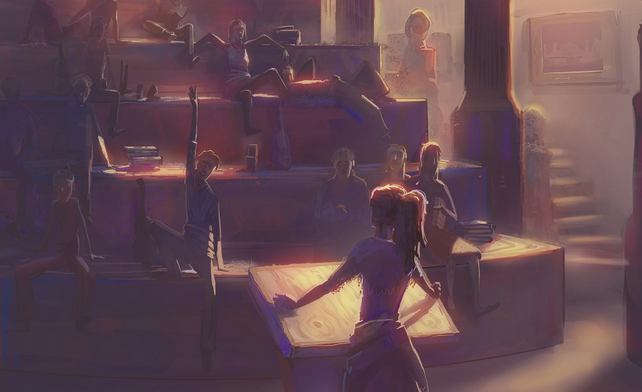Most stories show good vs. evil. There are the good guys who everyone loves and roots for, and the bad-guys who we long to see defeated. It’s meant to mirror reality and show us how we’re supposed to handle light and darkness in the real world. For ages, both in fiction and non-fiction writers have attempted to explore these two kinds of characters, and generally the stories that attempt to do so fall into three categories.
The first kind is simple: everything is in black and white. The protagonists and antagonists are presented to you right away. The two sides are crystal clear. This kind of story isn’t necessarily bad, it’s just seen as less complex and is often associated with children’s TV shows such as PJ Masks or Spidey’s Amazing Friends.
The second kind is a much more common troupe in today’s fiction. Often the good and evil characters are confused, leaving you lost when you try to root for anyone. The ‘antagonist’ is just misunderstood and most often every ‘protagonist’ has killed someone in their past. But none of them have had to deal with the consequences. They’re all just so broody and attractive that they don’t have time to consider whether or not their actions are right.
The third type of story is the perfect medium. It’s the balance between the first two, and realistically portrays a spectrum of morality without failing to promote goodness. How can we write this kind of story? How can we accurately represent darkness and light without compromising our values? How can you stay on this balance without adding yet another novel to the long list of fiction without a moral compass?
A debut fantasy novel, A Study of Shattered Spells, has just the answer.
A Study Of Shattered Spells
Kalina once fought for her country as a soldier in a world where music wields magic. However, since her cello was destroyed, she was forced to retire from the battlefield and now serves as a teacher at Chintor Academy.
Not only is she expected to fill the shoes of a normal teacher (even without the experience or ability to wield magic), but she’s also given the impossible task of training the prodigy and exalted Chosen One, Emil. This boy is destined by prophecy to destroy their enemies and win the war once and for all. However, Kalina soon discovers that Emil is not only unprepared for the battlefield, but also unwilling to work with others and cruelly manipulative of everyone around him. In short, he’s a bully. But, anyone in a position of power that could influence him is either supportive of the way he treats others or is too blinded by his puppy-dog eyes to make a difference. He pretends to be the victim any chance he gets.
At first, Kalina doesn’t see any of this. The boy did grow up in an abusive home, and the entire fate of the country weighs on his shoulders. She takes her co-workers’ advice and gives Emil as much patience and grace as she can muster. She falls for all of his fake tears, convinced that there must be some good and truth in him somewhere. But, as the story progresses, it’s made clear that, though he was chosen by the prophecy, Emil is wicked and would do anything he could to hurt the others around him if it meant he ends up on top.
How to Write Morally Gray Characters
In this story, morally gray characters are hidden in every corner of Chintor Academy. From stubborn, prideful professors to blind Head Mages, it’s hard to tell who Kalina can trust. Even Emil seems like he at least wants to do the right thing.
When he makes a bad decision or does something wrong, he only pretends to feel regret. He cries and puts on a big show while explaining that it’s not his fault, but that’s not the same thing. The Head Mage, Kalina’s co-workers, and many others are really good at pretending to be good.
In A Study of Shattered Spells there are villains and there are heroes, but that fact is not made obvious at the beginning of the story. At first, like I mentioned in my article on bullies, everyone may be doing the wrong thing, but it seems to ultimately be for the right reason. Each teacher has their own opinion of how to handle the students, but their worldviews each bring something beneficial to the school. Emil may be twisting the emotions of those around him, but it’s coming from a good heart. So many of these characters are the textbook definition of being morally gray.
By the end, however, lines are clearly drawn. The people who once seemed helpful turned out to be hypocrites or manipulative. In the climax, when everything comes to a head, it is finally revealed who truly had a good heart and who was only in it for themselves. The heroes are exalted and the villains are condemned.
When you think about it, this is how real life works. Bullies will always hide. People who are truly bad won’t just come out and admit it. In fact, most of the time, real villains are so deep in their own darkness that they don’t even see it as dark. They think they’re in the right. Many characters, especially Emil, hold this position, and it’s hurting the others around them. That’s why, in the climax, everyone’s real role should be revealed. That’s the true purpose of a climax, after all — to test a character past the point of endurance and reveal their true nature. When that nature isn’t revealed, and characters like Emil and the corrupt teachers around him remain morally gray even through the climax, you end up writing yet another battle between characters across a gray scale, with no moral compass and no clear sense of right and wrong. The battle will end up dull and uninteresting, since there’s no real reason for one side to win over the other. But your story doesn’t have to be that way.
If you want to realistically portray morally gray characters, bring out their true colors in the end. Don’t directly announce who’s right and who’s not, but at the same time don’t confuse darkness and light. Let the truth come out gradually until, by the end, it’s clear which side everyone is on. The villains will always try to justify their actions and the heroes may make mistakes, but at the end of the day an unyielding moral compass will guide your heroes onto victory .



Let us know:
What morally gray characters do you enjoy reading about? What side did they end up on in the end?


Hello, I’m Sophia! I’m a child of God and I (if you couldn’t tell already) love to write! I’m also a total theater kid and strong dessert (specifically cupcake) enthusiast. For as long as I can remember, I’ve enjoyed both reading and making my own stories. I’m so glad I get to share with you what I’ve learned from some of my favorite (or sometimes least favorite) stories on this blog.


Ah, yes. Modern fiction really seems to have a problem with morally gray characters. This is the article modern authors should really read!
Thanks! I hope some modern authors fix this problem as well…
Personally, I try to make my protagonists good, and put them into a morally gray world. Part of the conflict in my book is the protagonists trying to figure out who exactly their real enemy is when no one’s true intentions are clear. Especially in my world, where almost anyone could be an enemy.
Ooo yeah that’s one way to do it to! Making the protagonist a beam of light in a confusing world is often a sure way to make them likable. As long as the morally grey characters around them follow this formatting, that should work (: